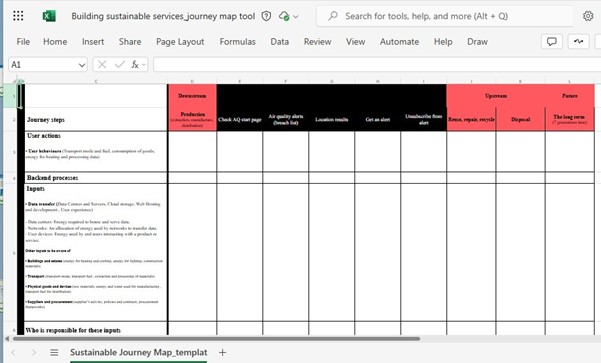This is the second blog in a series on product managing the design of sustainable services written by Lucy Stewart and Katie Marcus, product managers working in air quality improvement at Defra.

Digital services have environmental impact. Every search query, data download, and server request uses energy and generates emissions. As product managers working on air quality improvement, we wanted to understand and reduce the environmental impact of our own service: Get Air Quality Data. This is in line with Defra digital sustainability strategy 2025-2030, which sets out the group vision to minimise the environmental, economic and social impact of its ICT operations.
This service enables users to access air pollution data and information. While our work helps monitor and improve air quality, we recognised that delivering and maintaining the service itself has environmental consequences. We ran a workshop to map these impacts and identify where we could make improvements.

Figure 1: The sustainable services journey mapping tool used in the workshop. By clarifying the journey stages together, the tool helps teams query where energy is needed to run the service and supports teams to identify where there are opportunities to reduce the carbon outputs. A template for the tool is provided at the end of this blog post.
What we did
We brought together members of our cross-functional team including designers, lead statisticians, developers and programme managers, to examine our service’s environmental ‘inputs’ (the resources used to design, deliver and run the service) and ‘outputs’ (waste, emissions and pollution generated from these actions).
Using a journey mapping tool we identified where these inputs and outputs occur across the service lifecycle. We then modelled out the impact of these inputs and outputs from carbon emissions to biodiversity loss, exploitation and inequality and integrated optimisations into our product roadmaps and working practices.
What we learned
The service is a non-transactional digital service, but allows users to download large volumes of data, which makes hosting, processing and storing data the main contributors to energy use. Together we learned:
- Data duplication is energy-intensive - each query accesses and processes the entire database
- User experience - we can optimise the user journey to encourage smaller, targeted downloads matched to actual needs rather than defaulting to large datasets. We can even encourage users to download at certain times of day for more efficient processing
- Our working practices matter - how we work can and should be optimised to reduce impact alongside the service itself, and this is well within our control
- Collaboration - the need to work collaboratively with suppliers and business partners to influence ‘upstream’. We recognised that the further ‘up the chain’ you can go, the bigger impact we could have at reducing carbon emissions.
Next steps
As a team we’re currently lacking defined metrics and a consolidated methodology for calculating our ultimate environmental impact. However, this workshop demonstrated the value of bringing service teams together around sustainability questions. The conversation was lively and focussed our team’s creativity to look at the design and development of the service in new ways.
As product managers, we’re empowered to integrate sustainability concerns into roadmaps, KPIs and working practices. To put the workshop findings into action, we used a framework of 10 initiatives from Jisc's ‘Driving digital sustainability’ workshop. This workshop helped us assess which initiatives we can implement quickly and easily, versus those which require additional support or collaboration, longer term.
Quick wins:
- Reduce download bandwidth and computational resource by improving data storage, helping users to only download the data that they need, labelling large file sizes, and limiting the sending of non-essential alerts.
- Design user journeys as a text-based experience by default to reduce page load, offering explicit choices to access richer content like interactive maps or videos when needed. This aligns closely to GOV.UK design principles of accessibility and simplicity.
- Plan for longevity: use standard tools, patterns and components to plan for ease of iteration and future maintainability. The GOV.UK Design System and Component Library give us a strong start here.
- Collect and report on usage analytics in live services to assess the impact of each step in the user journey and identify areas for further optimisation.
Longer term goals:
- Establish consistent standards and KPIs for all services across the Environmental Quality delivery group and a shared methodology for calculating our carbon impact. Aligning sustainability goals with programme-wide strategy ensures environmental impact is considered early and built in from the start.
- Reduce infrastructure waste through test and development optimisation. Small improvements in day-to-day decisions and practices can deliver significant savings at scale. While we already have sustainability criteria in place as part of the procurement process, we will continue to positively influence our development suppliers to measure and improve their practices.
- Tackle legacy systems - running concurrent live services consumes resources and increases emissions, costs, and complexity. We are currently maintaining the existing UK Air website while developing new services. We hope to mitigate this through 2026 by taking a minimal viable product (MVP) approach and challenging requests for additional functionality and content that do not support our decommissioning goals.
In summary
We have a simple strategy of reducing the environmental impact of our service's inputs and outputs by delivering our services more lightly and efficiently, reducing waste across our entire pipeline, from planning and design to build and go-live. We will need to leverage all members of our cross-functional teams to realise this, as well as working with stakeholders and partners to maximise potential impact.
Even without the perfect processes and measurement tools in place, we believe that any progress is valuable, and hope these practices become the default for all Defra delivery teams.
We will share more as we learn and put initiatives into action. In the meantime, if you would like to access the Sustainable journey mapping tool to try with your own service, email lucy.stewart1@defra.gov.uk or katherine.marcus@defra.gov.uk

Leave a comment